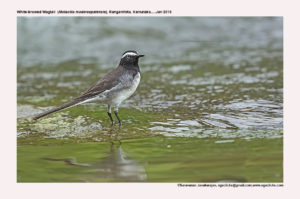
White-browed Wagtail Motacilla madaraspatensis
Etymology:
- Motacilla : Greek word muttex type of birdmentioned by Hesychius. It is a diminutive of motare, ” to move about”, from medieval times it led to the misunderstanding of cilla as “tail”.
- Madaraspatensis: From Madras ( now Chennai) in India
Vernacular Names: Hindi: Mamula, Bhuin mamula, Khanjan, Sans: Bhat shabal khajjan, Pun: Wadda mamola, M.P.: Nachangol, Hata rowe, Ass: Balimahi, Tipochi, Mani: Khongrangchak, Guj: Khanjan, Mar: Kavdya dhobi, Thorla dhobi, Kavda parit, Shabal, Pandhrya Bhuvai Cha Dhobi, Ta: Vaal-ati kuruvi, Vannathi kuruvi, Kulatthu kuruvi, Te: Sakala sarela-gadu, Batta kampa jitta, Mal: Valukunukki pakshi, Kan: Kappu bili sipilae
Distribution in India: Wide spread resident in India.
Description: Size of 21–24 cm; wt. of 30–36 g. It is a large wagtail. The male has all-black head except for broad white supercilium from bill to rear of ear-coverts, very thin white crescent below eye. The upperparts are mostly black, median and greater wing-coverts are mostly white, primary coverts are black and edged white. The remiges are blackish, tipped white; primaries with basal two-thirds are also white. The secondaries with basal half of outer webs are white, much of closed wing appearing white like a large white wing patch in flight. The tail is black, outer two rectrices are white with inner webs edged black; throat and side of neck to upper breast are black, rest of underparts are white. It has greyish wash on flanks, underwing-coverts are whitish; iris is dark brown; bill and legs are blackish. The female is usually greyer or duller black above, primaries are browner. The immature has supercilium shorter that starts from above eye, black areas as in adult of upperparts are greyish-brown, breast side is tinged greyish-buff, rest of underparts are white; bill is more brownish, pinkish base to lower mandible.
Habitat: It is found in watercourse, streams and rivers, especially smooth-flowing rivers with rocks and stony shoals, but occurs along any watercourse; also at irrigation tanks, lakes, pools and wells, and sometimes in paddy fields and on lawns. It is found from lowland up to 2200 m.
Food habits: It eats insects, especially small coleopterans, grasshoppers and dragonflies, also snails and other small items. It picks prey items from sand and among pebbles, usually along water’s edge, while walking or running..
Breeding habits: They breed in Mar–Jun in North India and Dec–Jun in South India, coinciding with low water levels in dry season. They are monogamous and territorial. The nest is built by both sexes. The nest is a bulky structure of roots, grass and various materials, neat cup lined with hair or wool, placed near water in variety of sites, including hole in bank, wall or building, ledge under bridge, crevice in tree trunk or rock face, in clump of vegetation on wall or rock or in disused nest of Dipper. They lay a clutch of 3–5 eggs. The young are cared for by both parents.